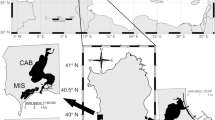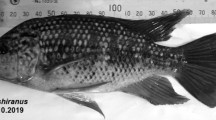Abstract
In India, over the past 50 years, aquaculture practices of species such as those used for Clarias batrachus were developed without adequate regulatory oversight. In these situations, it is important to consider the influence that genetic factors can have on such vulnerable aquaculture species. Population genetic structure can be evaluated through the use of neutral molecular markers, and this can aid in predicting the risk of the demise of populations and for framing management strategies to conserve remaining populations. The study presented here reports on the genetic status of C. batrachus populations through the analysis of data collected using 22 microsatellite markers from seven natural and one hatchery population. The mean values for observed heterozygosity across loci within populations ranged from 0.242 to 0.485. Measures of genetic differentiation were low overall, with mean values for FST of 0.270, FIS of 0.113 and FIT of 0.353. An AMOVA analysis revealed that percentages of variation among and within populations were 27.16 and 6.86, respectively, and Bayesian clustering analyses showed a population subdivision consisting of five clusters with admixture of haplotypes from other populations leading to genetic bottleneck. We also examined how hatchery management factors leading to excessive exchanges of fish between river systems through could impact the structure of the C. batrachus populations. Overall, this study shows how the systematic use of molecular markers can facilitate the development of management policies for these populations and for the development of a comprehensive set of rules for hatcheries and aquaculture practices, including avoidance of excessive homozygosity by avoiding repeated use of feral broodstock and their interrogation.



Similar content being viewed by others
References
Allendorf FW, Leary RF, Spruell P, Wenburg JK (2001) The problems with hybrids: setting conservation guidelines. Trends Ecol Evol 16:613–622. https://doi.org/10.1016/S0169-5347(01)02290-X
Behera BK, Vishwamitra SB, Ajaya KR, Sudip P, Kavita K, Debabrata P, Pronob D, Pranaya KP, Dharmendra KM, Bhakta D, Basanta KD, Joykrushna J (2018) The population structure and genetic divergence of Labeo gonius (Hamilton 1822) analyzed through mitochondrial DNA cytochrome b gene for conservation in Indian waters. Mitochondrial DNA A 29(4):543–551
Belkhir K, Borsa P, Goudet J, Bonhomme F (1999) Genetix: logiciel sous Windows pour la génétique des populations, Version 4.02. Montpellier (France): Laboratoire Genome and Population, CNRS-UPR, Université De Montpellier II. Program available in https://kimura.univ-montp2.fr/genetix/ (1996–2004)
Benjamini Y, Hochberg Y (1995) Controlling the false discovery rate: a practical and powerful approach to multiple testing. J R Stat Soc Ser B 57:289–300
Bergh MO, Getz WM (1989) Stability and harvesting of competing populations with genetic variation in life history strategy. Genetics 113:939–965
Bondad-Reantaso MG (2007) Assessment of freshwater fish seed resources for sustainable aquaculture. FAO Fisheries Technical Paper. No. 501. Rome, FAO. 2007. 628 p
Cornuet JM, Luikart G (1996) Description and power analysis of two tests for detecting recent population bottlenecks from allele frequency data. Genetics 144:2001–2014
DeWoody JA, Avise JC (2000) Microsatellite variation in marine, freshwater and anadromous fishes compared with other animals. J Fish Biol 56:461–473
Du Y, Zou X, Xu Y, Guo X, Li S, Zhang X, Su M, Ma J, Guo S (2016) Microsatellite loci analysis reveals post-bottleneck recovery of genetic diversity in the Tibetan antelope. Sci Rep 6:35501. https://doi.org/10.1038/srep35501
Dudgeon D, Arthington AH, Gessner MO, Kawabata ZI, Knowler DJ, Lévêque C et al (2006) Freshwater biodiversity: importance, threats, status and conservation challenges. Biol Rev 81:163–182. https://doi.org/10.1017/S1464793105006950
Earl DA, von Holdt BM (2012) STRUCTURE HARVESTER: a website and program for visualizing STRUCTURE output and implementing the Evanno method. Conserv Gen Resour 4:359–361
Evanno G, Regnaut S, Goudet J (2005) Detecting the number of clusters of individuals using the software structure: a simulation study. Mol Ecol 14:2611–2620
Excoffier L, Lischer HEL (2010) Arlequin suite ver. 3.5: a new series of programs to perform population genetics analyses under Linux and Windows. Mol Ecol Resour 10:564–567
FAO (2015) Aquaculture seed and feed production and management in Bangladesh—status, issues and constraints, by Hasan MR, Arthur JR. FAO, Rome. pp106.
Guo SW, Thompson EA (1992) Performing the exact test of Hardy-Weinberg proportion for multiple alleles. Biometrics 49(2):361–372
Hale ML, Burg TM, Steeves TE (2012) Sampling for microsatellite-based population genetic studies: 25 to 30 individuals per population is enough to accurately estimate allele frequencies. PLoS ONE 7(9):e45170. https://doi.org/10.1371/journal.pone.0045170
Hauser L, Adcock GJ, Smith PJ, Ramírez JHB, Carvalho GR (2002) Loss of microsatellite diversity and low effective population size in an overexploited population of New Zealand snapper (Pagrus auratus). Proc Natl Acad Sci USA 99:11742–11747
Hossain Q, Hossain MA, Parween S (2006) Artificial breeding and nursery practices of Clarias batrachus (Linnaeus 1758). Sci World 4:32–37
Islam MN, Islam MS, Alam MS (2007) Genetic structure of different populations of walking catfish (Clarias batrachus L.) in Bangladesh. Biochem Genet 45(9–10):647–662
Kang B, He DM, Perrett L, Wang HY, Hu WX, Deng WD, Wu YF, (2009) Fish and fisheries in the Upper Mekong: current assessment of the fish community, threats and conservation. Rev Fish Biol Fish 19:465–480
Khedkar GD, Reddy AC, Mann P, Ravinder K, Muzumdar K (2010) C. batrachus (Linn 1758) population is lacking genetic diversity in India. Mol Biol Rep 37:1355–1362
Khedkar GD, Tiknaik AD, Shinde R, Kalyankar AD, Benny Ron T, Haymer D (2014a) High rates of substitution of the native catfish Clarias batrachus by Clarias gariepinus in India. Mitochondrial DNA A 27(2016):569–574. https://doi.org/10.3109/19401736.2014.905863
Khedkar GD, Tiknaik AD, Kalyankar AD, ReddyKhedkar CSACD, Benny Ron T, Haymer D (2014b) Genetic structure of populations and conservation issues relating to an endangered catfish, Clarias batrachus in India. Mitochondrial DNA A 27(2016):1181–1187. https://doi.org/10.3109/19401736.2014.945524
Khedkar GD, Lutzky S, Rathod S, Kalyankar AD, David L (2014c) A dual role of dams in fragmentation and support of fish diversity across the Godavari River basin in India. Ecohydrology 7:1560–1573. https://doi.org/10.1002/eco.1470
Latch EK, Dharmarajan G, Glaubitz JC, Rhodes OE (2006) Relative performance of bayesian clustering software for inferring population substructure and individual assignment at low levels of population differentiation. Conserv Genet 7(2):295–302
Li L, Lin H, Tang W, Liu D, Bao B, Yang J (2017) Population genetic structure in wild and aquaculture populations of Hemibarbus maculates inferred from microsatellites markers. Aquac Fish 2(2):78–83. https://doi.org/10.1016/j.aaf.2017.03.004
Mahesh S, Kalyankar A, Khedkar CD, Shingare M, Khedkar GD (2020) A review on shrimp aquaculture in India: historical perspective, constraints, status and future implications for impacts on aquatic ecosystem and biodiversity. Rev Fish Sci Aquac. https://doi.org/10.1080/23308249.2020.1723058
Ng HH, Kottelat M (2008) The identity of Clarias batrachus (Linnaeus, 1758), with the designation of a neotype (Teleostei: Clariidae). Zoo J Linn Soc 153:725–732
Page RDM (1996) TreeView: an application to display phylogenetic trees on personal computers. Comput Appl Biosci 12:357–358
Peakall R, Smouse PE (2012) GenAlEx 6.5: genetic analysis in excel. Population genetic software for teaching and research—an update. Bioinformatics 28(19):2537–2539
Piry S, Luikart G, Cornuet JM (1996) BOTTLENECK: A computer program for detecting recent reductions in the effective population size using allele frequency data. J Hered 90(4):502–503
Pritchard JK, Stephens M, Donnelly P (2000) Inference of population structure using multilocus genotype data. Genetics 155:945–959
Qi P, Qin J, Xie C (2015) Determination of genetic diversity of wild and cultured topmouth culter (Culter alburnus) inhabiting China using mitochondrial DNA and microsatellites. Biochem Syst Ecol 61:232–239
Rao GR, Tripathi SD, Sahu AK (1994) Breeding and seed production of the Asian catfish Clarias batrachus (Linnaeus). Cent Inst Freshw Aquac 1994:29
Raymond M, Rousset F (1995) GENEPOP: population genetics software for exact tests and ecumenicism. J Hered 86:248–249
Reichel K, Masson JP, Malrieu F, Arnaud-Haond S, Stoeckel S (2016) Rare sex or out of reach equilibrium? The dynamics of FIS in partially clonal organisms. BMC Genet 17:76
Reiner A, Yekutieli D, Benjamini Y (2003) Identifying differentially expressed genes using false discovery rate controlling procedures. Bioinformatics 19:368–375
Rhymer JM, Simberloff D (1996) Extinction by hybridization and introgression. Annu Rev Ecol Syst 27:83–109. https://doi.org/10.1146/annurev.ecolsys.27.1.83
Selkoe KA, Gaines SD, Caselle JE, Warner RR (2006) Current shifts and kin aggregation explain genetic patchiness in fish recruits. Ecology 87:3082–3094
Slatkin M (1995) A measure of population subdivision based on microsatellite allele frequencies. Genetics 139:457–462
Srivastava S, Kushwaha B, Prakash J, Pandey M, Agarwal S, Kumar R, Nagpure NS, Singh M, Das P, Joshi CG, Jena JK (2017) Identification and characterization of SSRs in Clarias batrachus and their application in population study. Fish Sci 83:265–272
Takezaki N, Nei M, Tamura K (2010) POPTREE2: software for constructing population trees from allele frequency data and computing other population statistics with windows interface. Mol Biol Evol 27(4):747–752
Tiknaik A, Kalyankar A, Shingare M, Suryawanshi R, Prakash B, Sontakke TA, Nalage D, Sanil R, Khedkar G (2019) Refutation of media reports on introduction of the red bellied piranha and potential impacts on aquatic biodiversity in India. Mito DNA A 30(4):643–650. https://doi.org/10.1080/24701394.2019.1611798
VanderBank FH, Grobler JP, DuPreez HH (1992) A comparative biochemical genetic study of three populations of domesticated and wild African catfish (Clarias gariepinus). Com Biochem Phys 101(B):387–390
Volckaert FAM, Helleman BAS, Poyaud L (1999) Nine polymorphic microsatellite markers in the South East Asian Catfishes Pangasius hypophthalmus and Clarias batrachus. Anim Genet 30:383–384
Weir BS, Cockerham CC (1984) Estimating F-statistics for the analysis of population structure. Evolution 38:1358–1370
Wright S (1951) The genetical structure of populations. Ann Eugenics 15:323–354. https://doi.org/10.1111/j.1469-1809.1949.tb02451.x
Yang M, Tian C, Liang XF, Zheng H, Zhao C, Zhu K (2015) Genetic structure and diversity in natural and stocked populations of the mandarin fish (Siniperca chuatsi) in China. Genet Mol Res 14(2):5153–5160. https://doi.org/10.4238/2015
Yue GH, Kovacs B, Orban L (2003) Microsatellites from Clarias batrachus and their polymorphism in seven additional catfish species. Mol Eco Resour 3(3):465–468
Zhang ZW, Cao ZM, Yang H, Wang JL, Cao JL, Han YP, Wu TT (2006) Microsatellites analysis on genetic variation between wild and cultured populations of Ctenopharyngodon idella. Zool Res 27:189–196
Author information
Authors and Affiliations
Corresponding author
Ethics declarations
Conflict of interest
The funding from Department of Biotechnology, Government of India, New Delhi (vide File No. 102/IFD/SAN/4469/2011-2012 Dated Feb 17, 2012) and DR. Babasaheb Ambedkar Marathwada University Aurangabad, India (Ref. No. STAT/IV/RC/Dept./2019-20/295-96 dated 13.06.3019) to G. D. Khedkar are greatly acknowledged. We declare that we have no financial or personal relationships relating to the work submitted here that could influence or bias this work.
Additional information
Publisher's Note
Springer Nature remains neutral with regard to jurisdictional claims in published maps and institutional affiliations.
Electronic Supplementary Material
Below is the link to the electronic supplementary material.

Rights and permissions
About this article
Cite this article
Tiknaik, A., Khedkar, C., Khedkar, G. et al. Microsatellite Genotyping Corroborated Loss of Genetic Diversity in Clarias batrachus as a Result of Lack of Regulatory Reforms in Aquaculture. Biochem Genet 58, 595–616 (2020). https://doi.org/10.1007/s10528-020-09963-0
Received:
Accepted:
Published:
Issue Date:
DOI: https://doi.org/10.1007/s10528-020-09963-0




